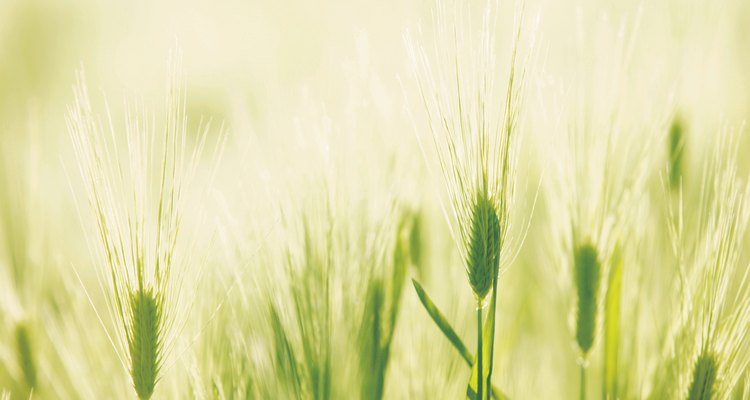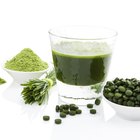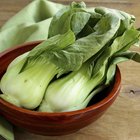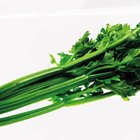
GYRO PHOTOGRAPHY/amanaimagesRF/amana images/Getty Images
Although barley is better known for the grains produced by mature barley plants, barley grass harvested from an early stage in the plant's growth is a popular health food due to its wealth of nutrients. Young cereal grasses like barley and wheat grass contain similar types of nutrients as those found in green, leafy vegetables like spinach but in a more concentrated package.
Phytochemical Profile
Barley grass contains a type of nutrients found in plant foods called phytochemicals. These are not essential nutrients, but may nevertheless benefit your health. Like other green, leafy plant foods, barley grass contains the phytochemical chlorophyll as well as a class of phytochemicals called carotenoids. According to the Linus Pauling Institute, chlorophyll derivatives have been used orally to control internal odors and as a topical treatment for wounds. Scientists also are studying whether chlorophyll might be useful in treating certain types of cancers. Carotenoids found in barley grass and other vegetables also have antioxidant effects which may prove useful in treating and preventing cancer and other chronic diseases, although further research is needed to definitively support these claims.
Nutrients
In addition to phytochemicals, barley grass is densely packed with both essential micronutrients such as vitamins and minerals and macronutrients such as protein and fiber. According to an Oprah.com article, while barley grass has many of the same nutrients as other green, leafy vegetables like spinach, it offers these nutrients in a more concentrated package than other veggies, meaning small servings of barley grass pack a lot of nutrition. The PeerTrainer website notes that a typical serving of barley grass in powdered form is 5 to 10 grams. That serving contains 1,750 IU of vitamin A, 11 milligrams of vitamin C, 280 milligrams of vitamin K, 18 milligrams of calcium, 3.6 milligrams of magnesium and 2 milligrams of iron. A serving also contains 800 milligrams of protein and 600 milligrams of fiber.
Dry Versus Fresh
Barley grass is sold in dried or powdered formulations, and you can also take barley grass in the form of juice from freshly harvested plants. Dried grass is less messy to handle than fresh and is easier to take for people who don't enjoy its strong taste; however, Oprah.com notes that juice made from fresh grass contains more active enzymes and phytochemicals than dried grass. Juice made from barley and wheat grass is often sold at juice bars, and you can also make your own barley grass juice using a juicing machine and fresh grass sold at health food markets. You even can buy grass seeds or kits to grow your own grass at home.
Comparison with Wheat Grass
There are few nutritional differences between barley grass and wheat grass. Both are cereal grasses which, when young, have nutrient profiles more like those of vegetables rather than grains. Like barley grass, wheat grass is also rich in chlorophyll, vitamins A and C and minerals like iron and calcium. Both barley and wheat grass act as antioxidants which reduce inflammation and may possibly confer other health benefits as well.
Related Articles

Juicing for Wrinkles

What Are the Benefits of Aloe Vera & ...

What Are the Benefits of Kyo-Green?

How to Use Wheatgrass for Washing Hair

Benefiber Ingredients

Bok Choy Nutrition

Where to Buy Pomegranate Juice

Can You Juice Celery Leaves?

The Use of Neem Juice in Skin Care as ...

What Is Green Magma?

How to Eat Oat Grass

The Safety of Benefiber

Bitter Melon for Acne

Noni Juice Benefits for Skin

What Is Arnel Vintage Material Fabric?

Vitamins for Mental Alertness

Is Wheat Grass an Alkalizing Food?

Calories of Tuna in Sunflower Oil

Wild Yam for Hair Growth

How to Choose Quality Korean Ginseng
References
Writer Bio
Shannon George, former editor-in-chief of the trade magazine "Prime," holds a Bachelor of Arts in English from San Diego State University. Her health interests include vegetarian nutrition, weight training, yoga and training for foot races.
Photo Credits
GYRO PHOTOGRAPHY/amanaimagesRF/amana images/Getty Images